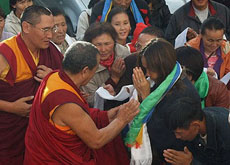| | | |
Archive
| « September 2009 » |
|---|
| Mo | Tu | We | Th | Fr | Sa | Su |
|---|
| | 1 | 2 | 3 | 4 | 5 | 6 | | 7 | 8 | 9 | 10 | 11 | 12 | 13 | | 14 | 15 | 16 | 17 | 18 | 19 | 20 | | 21 | 22 | 23 | 24 | 25 | 26 | 27 | | 28 | 29 | 30 | |
|
| | | |
|
|
|
|
|
|
|
19 September 2009 | Views: 3221 | Comments: 0 |
|
|
 On the invitation of the Kamby-Lama of Republic Tuva, the worthy Geshe-Lharamba Yonten Damcho, the abbot of the Drepung Gomang monastery, where currently Tuvan, Buryatian and Kalmyk monks are studying, came to Tuva. On the invitation of the Kamby-Lama of Republic Tuva, the worthy Geshe-Lharamba Yonten Damcho, the abbot of the Drepung Gomang monastery, where currently Tuvan, Buryatian and Kalmyk monks are studying, came to Tuva.
In the morning, there was a joint prayer ceremony with Tuvan monks in the “Tsechenling” khuree, where the Worthy Yonten Damcho greeted the citizens of the republic and thanked them for the invitation.
|
|
|
|
|
|
From info by savetibet.ru, translated by Heda Jindrak |
|
|
|
|
|
|
|
|
15 September 2009 | Views: 3851 | Comments: 0 |
|
|
 The first motor vehicle accident in Tuva, black and red caviar by the kilogram, Chinese shops, the Harley motorcycle of the first director of the museum, the Kyzyl flood of 1945, first theatrical premieres, battle with the swamps for hot water supply for the Tuvan capital, - you can read about all that, and much more, in the memoirs of the Honored citizen of Kyzyl, Anatolii Aleksandrovich Matyushov. (1926-2006). The first motor vehicle accident in Tuva, black and red caviar by the kilogram, Chinese shops, the Harley motorcycle of the first director of the museum, the Kyzyl flood of 1945, first theatrical premieres, battle with the swamps for hot water supply for the Tuvan capital, - you can read about all that, and much more, in the memoirs of the Honored citizen of Kyzyl, Anatolii Aleksandrovich Matyushov. (1926-2006).
|
|
|
|
|
|
Dina Oyun, translated by Heda Jindrak |
|
|
|
|
|
|
|
|
8 September 2009 | Views: 3466 | Comments: 0 |
|
|
 — Valentina Yurievna, you presented the sum of your understanding of Tuvan musical culture in your book “Musical culture of Tuva in the XXth Century”, which was published in Moscow in 2007. — Valentina Yurievna, you presented the sum of your understanding of Tuvan musical culture in your book “Musical culture of Tuva in the XXth Century”, which was published in Moscow in 2007.
At first, you used to approach your subject with western education,, with western theory – you asked questions that you were taught to ask, measured by methods and instruments with which you were equipped during your studies.
Later, as you write, you started to comprehend that it is impossible to understand or document this culture by foreign means.
Tell us, please, for those that did no read your book, how did this change come about? What happened?
— That is a very interesting question. I think that my case is an interesting example for analysis of the methods of scientific study and evolution of the researcher herself, as at a certain moment, the material itself pushes her into movement.
|
|
|
|
|
|
Chimiza Lamajaa, Center of Asia, No.34. Translated by Heda Jindrak |
|
|
|
|
|
|
|
|
7 September 2009 | Views: 4580 | Comments: 0 |
|
|
 It can be very easy, or very complicated, to write about talented, creative, multifaceted people. It can be very easy, or very complicated, to write about talented, creative, multifaceted people.
It is possible to write a long biography, a rich characterization. But this can make the task more complicated: how to pick the main, the most important things, how to keep from drowning in epithets, titles, and accomplishments.
|
|
|
|
|
|
|
|
|
|
|
